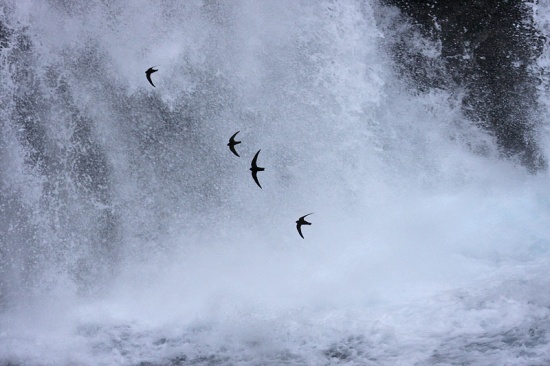Alternative name: American Black Swift

McArthur-Burney Falls Memorial State Park, Shasta County, California, USA, July 2008
- Cypseloides niger
Identification

Photo © by Glen Tepke
McArthur-Burney Falls Memorial State Park, Shasta County, California, USA, July 2008
A fairly large (15-18 cm (6-7.25 ins) in the nominate form of West Indies) black swift with slightly notched and relatively long tail.
At close range, white on forehead and brows may be visible.
The body is rather stocky, the wings relatively broad.
Geographic variation
Birds in the Caribbean average smaller with more deeply forked tail than birds in the USA. Recent photos in the Caribbean has shown variation within this group, with some birds showing a tail form similar in extent to members of genus Apus (such as Common Swift).
Distribution
The Black Swift is distributed from SE Alaska through SW USA, and Mexico to Costa Rica, and in the West Indies to Trinidad and Tobago to Guyana. Even southern populations (e.g., in the Lesser Antilles) are migratory, presumably wintering in South America, while the species is present year round in Hispaniola and Jamaica.
A highly migratory species, but the definitive wintering grounds are still unknown. Recorded in winter in Colombia.
Not globally threatened, abundant in parts of its range, uncommon in others.
Taxonomy
Forms a superspecies with White-chested Swift, Rothschild's Swift and Sooty Swift.
Subspecies
It's considered to have three subspecies[1]:
- C.n. borealis:
- C.n. costaricensis:
- From central Mexico to Costa Rica, smaller and darker than borealis
- C.n. niger:
- From Trinidad to the West Indies
Habitat
In the north of its range in a variety of open highland habitat. In the south around montane evergreen forest, also secondary growth. In eastern Caribbean, they often seem absent in good weather due to hunting very high, but in bad weather may hunt all the way down to sea level.
Behaviour
Like other Swifts highly gregarious, sometimes seen in flocks numbering hundreds or thousands of birds, often together with other Swift species. May travel long distances between nestplaces and feeding grounds.
Diet
Feeds on various insects, eg. wasps, bees or ants, taken in flight.
Breeding
Nests in June in the USA, earlier (May) in the south. Often near waterfalls. Needs darkness, water, inaccessibility, a good flyway, high relief and a rock niche to build its pad of moss and twigs, bound with mud. Lays one egg. Copulation takes place in flight, like in other Swift species.
Incubation by both adults, takes about 24 days. There are long periods between feeding and the young swift grows slowly. Fledging takes place at about 44 days.
Vocalisation
Call: a rapid, repetitive ci-chi-chi-chit
References
- Clements, J. F., T. S. Schulenberg, M. J. Iliff, D. Roberson, T. A. Fredericks, B. L. Sullivan, and C. L. Wood. 2018. The eBird/Clements checklist of birds of the world: v2018. Downloaded from http://www.birds.cornell.edu/clementschecklist/download/
- Whatbird.com
Recommended Citation
- BirdForum Opus contributors. (2025) Black Swift. In: BirdForum, the forum for wild birds and birding. Retrieved 2 May 2025 from https://www.birdforum.net/opus/Black_Swift
External Links
GSearch checked for 2020 platform.





